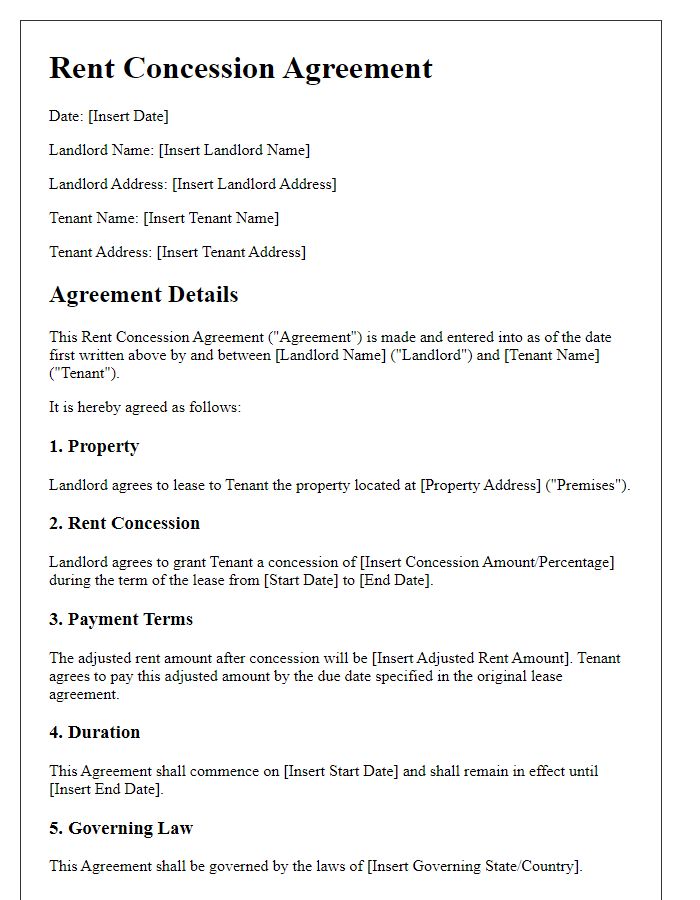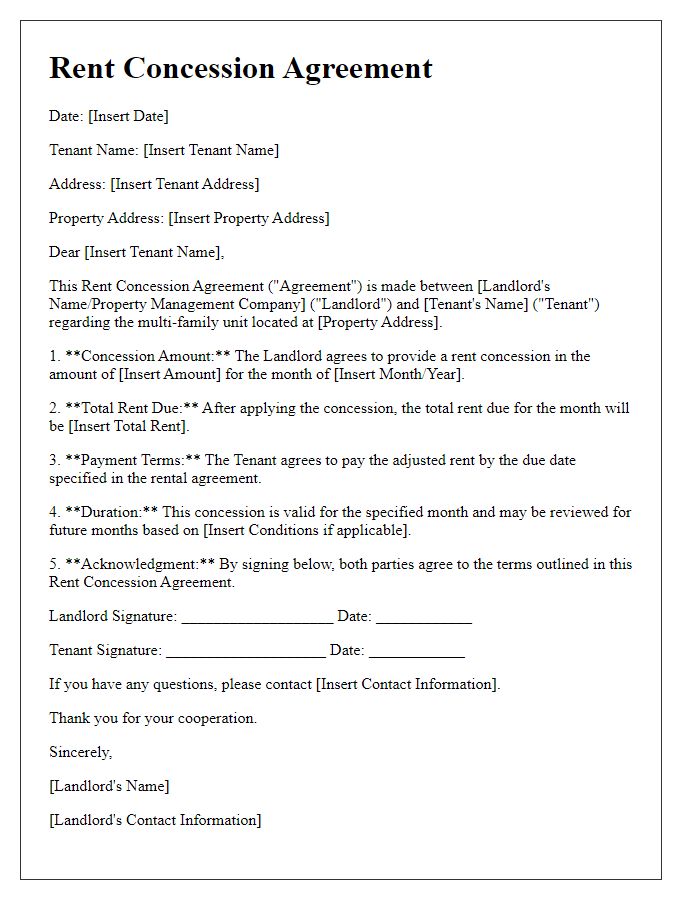When navigating the sometimes tricky waters of rental agreements, a rent concession can make a world of difference for tenants and landlords alike. This arrangement can provide tenants with temporary financial relief while allowing landlords to maintain occupancy and reduce vacancy risks. Understanding how to draft a rent concession agreement is essential for ensuring clarity and mutual satisfaction between both parties. So, if you're curious about the key elements to include in such a template, read on for valuable insights!

Tenant and landlord information
A rent concession agreement outlines the specific terms and conditions under which a landlord (property owner) may agree to reduce the rent for a tenant (renter), often due to financial hardship or other significant events. This agreement includes essential information such as the landlord's identity, including name and address, and the tenant's identity, including full name, contact information, and rental property address. Important details include the original rental amount (such as $1,200 monthly rent), the new reduced amount (for example, $1,000 monthly rent), effective duration of the concession (e.g., three months starting from November 1, 2023), and any stipulations regarding the tenant's obligations (like maintaining property conditions). The document may also indicate the reason for the concession, which can provide context for both parties. Signatures from both the landlord and the tenant solidify the agreement, ensuring both parties respect the new terms.
Property details and rent amount
The rent concession agreement outlines the terms of a temporary reduction in rent for a specific property, such as a residential unit at 123 Maple Street in Springfield. The usual rent of $1,500 per month may be decreased by 20% for the duration of this agreement, totaling $1,200 per month. This agreement applies from January 1, 2024, to June 30, 2024, fortifying the landlord-tenant relationship during economic fluctuations. Specific conditions for this concession, including maintenance responsibilities and payment deadlines, are clearly stated to ensure mutual understanding and compliance. This document serves both as a legal record and a tool for maintaining positive occupancy dynamics amid changing financial circumstances.
Concession terms and duration
A rent concession agreement outlines special arrangements between landlords and tenants regarding temporary rent reductions or credits. Specific terms can vary widely based on individual circumstances, such as lease duration and financial conditions. For example, a common concession might include a 20% reduction in rent for a three-month period (usually related to economic hardships or property improvements). Additionally, this agreement often stipulates the start and end dates of the concession, such as from January 1, 2024, to March 31, 2024, ensuring clarity about the timeframe. Important factors like the reason for the concession (e.g., COVID-19 impact, property renovations), obligations of both parties, and potential future adjustments to the rent may also be detailed in the document.
Justification for concession
A rent concession agreement outlines the terms under which a landlord agrees to reduce or waive rent payments for a tenant. Justification for a concession often includes economic hardship, significant property repairs, or market conditions influencing rental prices. In many cases, tenants may face unforeseen circumstances such as job loss or medical emergencies that hinder their financial stability. Additionally, landlords may consider local market conditions, such as a high vacancy rate in the vicinity or comparable rental prices dropping significantly, as justifiable reasons for offering concessions, aiming to retain tenants and reduce turnover costs associated with a vacant property.
Signature and date lines
A rent concession agreement outlines the terms of a temporary reduction or modification in rent. It typically includes details such as the parties involved (landlord and tenant), property address, new rental amount, concession duration, and signature lines. The signature lines provide space for the landlord and tenant to confirm acceptance of the agreement and its terms, along with the dates of agreement execution, ensuring both parties have legal acknowledgment of the changes made. Signature lines usually include names, titles, and spaces for the date to indicate when the concession was agreed upon.
Letter Template For Rent Concession Agreement Samples
Letter template of Rent Concession Agreement for Non-Profit Organizations

Letter template of Rent Concession Agreement for Temporary Rent Reduction












Comments